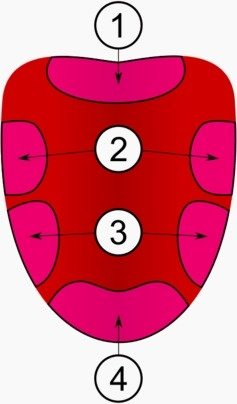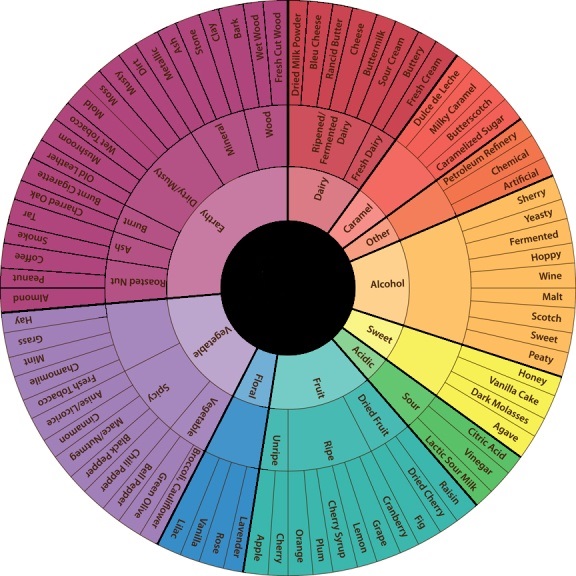Our tongue is an amazing muscular organ, capable of detecting a range of different flavours on its taste buds. Until fairly recently it was believed the tongue resembled a ‘map’ of regions that detected these different flavours in groups – salty, sweet, sour, bitter etc as presented by German scientist David P. Hanig. Recent findings show this was in fact, a miss translation. But it’s not just the tongue and its taste buds that is important when it comes to taste and flavour detection, the nose plays an equally, if not more important role. Without your sense of smell, the range of different flavours that your tongue can detect is dampened by a staggering 60%, that’s why when you are sick you can’t taste your food much.

You’re probably thinking what all this has to do with chocolate? Alot more than you imagine. Chocolate isn’t just a sickly sweet chunk of mayhem you can chuck in your mouth and chomp on without thinking, that’s candy – so any chocolate less than 25% cocoa solids (UK Standards). Fine chocolate is deliciously complex; the product of fermented, dried, roasted cacao beans that have been winnowed and conched with sugar for around 24 hours (minimum), before being tempered and molded into beautiful chocolate bars. It’s these chocolates that are judged at various chocolate awards around the world – including the Academy of Chocolate Awards and the International Chocolate Awards. Chocolate tasting, like wine tasting, involves more than just your sense of taste.
Firstly, chocolate should ideally be consumed at room temperature (or about 19-21°C if you’re in a hot climate). Therefor, ideally chocolate should not be stored in the fridge. If you have to, then its best to remove the chocolate from the fridge about 20-30 minutes before tasting. Even at room temperature the molecules in the chocolate will begin to move, ever so slowly, which means when you taste the chocolate, your mouth is able to melt the chocolate more effectively, and your tongue able to pick up on more subtle nuances of flavour more easily than if it was direct from the fridge.
Now you have the right chocolate environment for tasting, you can begin tasting your chocolate using the Sense by Sense Guide below.
Sense 1: Sight
The first thing you must do once removing your chocolate from its wrapper is to have a good look at and admire your chocolate. Good quality chocolate that has been well tempered will be a rich dark brown colour (sometimes tinged with a copper or red colour, but NEVER black – a sign the cocoa beans have been burnt in the drying or roasting process, and is a hint that cheap ones have been used). It should also have a lovely satin sheen to it.
If you see any white streaky or swirly patterns or what looks like a white layer over it this is known as a ‘fat bloom’ – due to it resembling a floral bloom. This is not mould, but does indicate that the chocolate has been incorrectly stored (often inevitable in hot countries), or incorrectly tempered (the final process of chocolate making when all the cocoa molecules, sugar molecules, cocoa butter molecules come together and crystalise into Beta crystals).

Another bloom, more noticeable once you have bitten into your chocolate, is a sugar bloom – more common when humidity and temperature are both too high, as the sugar molecules will re-crystalise separately from the cocoa molecules.
Sense 2: Feel
Most chocolate, regardless of quality or type (milk, white or dark) will begin to melt at body temperature. But you can determine a quality dark (plain) chocolate by breaking a small piece (about the size of a peppercorn) off and melting it between thumb and forefinger – once melted you will be left with a powdery residue as all the cocoa butter has been absorbed and left you with the cocoa mass (powder). The same is not true for milk or white chocolate due to the milk solids involved.
Sense 3: Listen
It’s worth listening to what chocolate has to say…no, that’s not crazy*! Hold a piece up to your ear and snap it in two. It should have a lovely clean, crisp ‘snap’ to it, indicating there is a good amount of cocoa involved and that the chocolate has been well tempered and correctly stored. If it crumbles or bends then that will indicate incorrect tempering.
*If you do hear your chocolate bunnies talking to you, you may need to seek help.

Sense 4: Smell
This is when your biggest sense comes in to play. It’s now time to give your chocolate a good, hard sniff. This is when your palette really becomes activated and your taste buds kick into gear. It is also often when your saliva glands begin to wake up too, ready for the oncoming food. You might detect smoky smells (more common with Indonesian chocolates due to drying techniques), fruity notes, peaty, sometimes even toffee or roasted coffee. Some people even detect notes of ‘fresh cut grass’ and mushrooms, but this by no means indicates your chocolate is ‘bad’.
Sense 5: Taste
Ok, I dragged that out a bit, now you can taste your chocolate, and will probably notice many more flavours than you ever knew were possible. Savour this part though – you will want to let the chocolate melt in your mouth, rather than immediately start munching on it. Lift your tongue to the roof of your mouth (as this is the warmest part) and let the chocolate begin to melt. You can also bring your sense of smell in to play here by breathing in through your mouth, momentarily hold your breath in, then breathe out through your nose. Repeat in reverse and you will notice even more flavours coming to the fore.
There are over 500 flavours that people can detect from chocolate, and these flavours will vary depending on the region the cocoa beans are from, and their genetic strain. People have even developed a Flavour Wheel, similar to that used for wine tasting, to help define what is tasted in the chocolate.

Be conscious of how the chocolate feels in your mouth too – silky, smooth, rough or grainy? Well tempered chocolate that has been conched for long enough should normally have a silky texture when it melts. ‘Stone ground’ chocolate will tend to have more of a gritty texture to is as it will have been ground by hand on a stone for a shorter period than in a conching machine. You should also notice after the chocolate has melted that there is no waxy or ‘cloying’ sensation left in your mouth, if there is, this is a sign that fats other than cocoa butter have been used.
With a fine quality dark chocolate, at least 60% or over, you should notice the flavours continuing to develop on your palate up to 15 minutes after first eating it, and the higher the %, the more satisfying it is! So really, you don’t need to scoff down that much, that quickly; just enjoy, and savour the flavour!

One thought on “The Science of Tasting Chocolate”